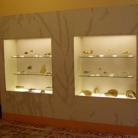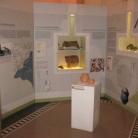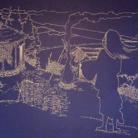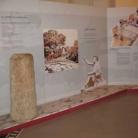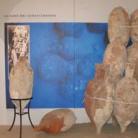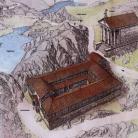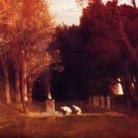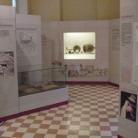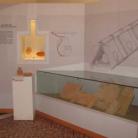Archaeological section “Lucus Bormani”
The new preparation of the Museo Civico Archeologico of Diano Marina, opened on 5th September 2004, has been planned and carried out by the Istituto Internazionale di Studi Liguri in agreement with the Town Council and the Soprintendenza per i Beni Archeologici della Liguria. In the Museum, composed of nine rooms and a multimedia room, are exposed the findings of the Diano Marina Gulf territory, from Berta Cape and Cervo Cape, dating from prehistory to late roman time.
Sala 1 - The infinite History / Environment and research
In this room there are the most ancient findings discovered in Diano Marina territory dating to Palaeolithic, fossils, tools and animal rests etc., a short introduction to the natural environment and to the history of the archaeological research carried out in these territories, which began in the second half of last century. The palaeo-ethnological collection of the museum is here exposed too.
Sala 2 - The first settlement
Several sporadic findings in the settlements of Diano Marina and San Bartolomeo al Mare, make archaeologists presume that in this area might exist a relevant coastal settlement dating to Bronze Age. Some wares dating from XVII to X century BC are here exposed (“impasto” dolia, bronze objects and arms).
Sala 3 - The ancient Ligurians
The frequentation of Diano Marina gulf, during the Iron Age and the immediate previous phases before the romanization, is documented by relevant findings, as the two hearths of Via Villebone (Diano Marina), which enforce the hypothesis of a settlement composed of inhabited spaces, where also amphorae coarse and fine wares imported from Massalia (Marseille) and Southern Italy (Tyrrhenian area) have been found.
Sala 4 - 553 miles from Rome
The roman archaeological testimonies let us collocate Lucus Bormani in the area between Berta Cape and Cervo Cape, as the ancient reports place it 15 miles away from Albingaunum (Albenga) and 16 miles away from Costa Balenae (Don Cape, Riva Ligure). The link with roman viability and particularly with via Iulia Augusta track, is here documented by the resin caulk of the milestone found at Chiappa, hamlet of San Bartolomeo al Mare. The Lucus Bormani was included in the municipium of Albingaunum and its inhabitants were ascribed to Publilia tribe.
Sala 5 - The journey
The fifth room of the museum is dedicated to the journey, via land and via sea, to the goods transported along the main trade lines, to transport means which document trade traffics and exchanges in ancient times. Particular evidence is given to the wreck of Diano Marina, a dolia ship sunk around the I century AD in the Diano Marina gulf. In this room even 14 roman coins dating from 40 BC to 315-316 AD and found in the area are exposed.
Sala 6 - From the road web ...to internet web
Multimedia room equipped with 3 PCs.
Sala 7 - The halting station
The archaeological findings of Diano Marina gulf territory induced to position in this area the mansio of Lucus Bormani cited by the ancient sources. The position of the rests found between San Bartolomeo al Mare and the eastern slopes of Berta Cape and their architectonical typology seem to confirm, for this area, its function as a halting station along the via Iulia Augusta, built by the emperor Augusto in 13/12 BC to enable easier links to Gaul. In this room there are pottery and glasses collected in the archaeological excavation of La Rovere at San Bartolomeo al Mare and some amphorae coming from Diano Marina gulf.
Sala 8 - The sacred wood
The toponym Lucus Bormani recalls the ancient cults practised in this area since ever, in a sacred glade delimited by a wood (lucus), dedicated to Bormanus, god deriving from the pre-roman divinity Borman. During the roman period this cult flanked and was then transformed in that of Diana’s, goddess of hunting and woods, evoked nowadays in the coastal centres and in various villages of our valleys.
Sala 9 - Life
The excavations in Lucus Bormani allowed to know the area occupied by the roman settlement which extended from Capo Cervo to Capo Berta hill, with a possible agricultural occupation concerning even the neighbouring inland (findings at Diano Castello, Chiappa and Villa Faraldi).
Ware and excavated structures reveal various life and daily activities details practised by the ancient inhabitants; ceramics document pottery used at table, either to preserve food in dispense or to prepare and cook food in the kitchens. Bronze hooks, loom weights and clay fusaroles testify ancient inhabitants’ activities and uses.
Sala 10 - Late roman time
The coastal settlement of Lucus Bormani lasted in plain till late roman times (VI-VII centuries), when precarious defence conditions urged for a battlement on the protected hill behind the ancient mansio, where castrum Diani will rise in the area corresponding to the present Diano Castello.
Last life phases of Lucus Bormani concentrate mostly around Santi Nazario e Celso’s church which together with the small S. Siro’s church in Diano Castello territory, the ancient S. Pietro’s parish church in Diano San Pietro and Madonna della Rovere’s Sanctuary in San Bartolomeo al Mare, form the main centre for the diffusion of Christianity in our territory.
Two graves date to this period, one is a “cappuccina” tomb found along Corso Roma in Diano Marina, the other is a rupestrian grave found at Ciosi in Pairola, in the hinterland of San Bartolomeo al Mare.




